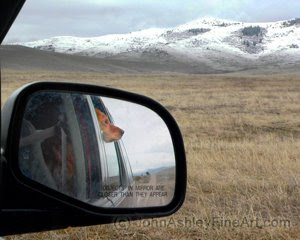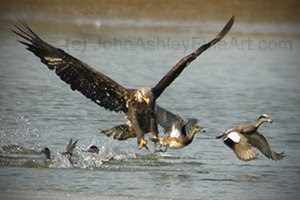Our calendar flipped past the first day of spring and right on into April, but the snow berms still looked the same around our house. So after five straight days of snow and dull gray skies, we made a deal. If Tracy finished with the taxes that she’s been avoiding, and if I finally finished grouting the tiles that I had laid weeks earlier, then we would take a whole day off to go searching for signs of spring.
 The forecast called for sunshine, and the sky was full of stars when we lifted our old dogs into the car before dawn. We quickly dropped in elevation and headed south toward the far end of the Flathead Valley. We weren’t in a big rush, but Highway Patrol Officer Denton did turn around just to visit with us and suggest that we slow down. Because of this, the sun peeked over the mountains before we were halfway there. After a few golden moments, the sun climbed into a growing bank of clouds. As the coffee started kicking in, I realized that the clear sky was fading in our rearview mirror, and we were driving into the gray curtains of snow clouds. Big, wet snowflakes – our first sign of spring.
The forecast called for sunshine, and the sky was full of stars when we lifted our old dogs into the car before dawn. We quickly dropped in elevation and headed south toward the far end of the Flathead Valley. We weren’t in a big rush, but Highway Patrol Officer Denton did turn around just to visit with us and suggest that we slow down. Because of this, the sun peeked over the mountains before we were halfway there. After a few golden moments, the sun climbed into a growing bank of clouds. As the coffee started kicking in, I realized that the clear sky was fading in our rearview mirror, and we were driving into the gray curtains of snow clouds. Big, wet snowflakes – our first sign of spring.  We were aiming for the National Bison Range, but a small group of Tundra Swans flew past our windshield and lured us onto the muddy back roads of Ninepipes National Wildlife Refuge. The main reservoir had iced-out and assorted ducks and geese were spread across the water. On a small island, four Bald Eagles studied the ducks from their perch in an old, gray cottonwood snag. On the adjacent island, another old cottonwood had finally fallen down, and the entire island was covered with noisy gulls staking out gravel for future nest sites.
We were aiming for the National Bison Range, but a small group of Tundra Swans flew past our windshield and lured us onto the muddy back roads of Ninepipes National Wildlife Refuge. The main reservoir had iced-out and assorted ducks and geese were spread across the water. On a small island, four Bald Eagles studied the ducks from their perch in an old, gray cottonwood snag. On the adjacent island, another old cottonwood had finally fallen down, and the entire island was covered with noisy gulls staking out gravel for future nest sites. The government built the two islands thinking they would make great duck nesting habitat, but the gulls and Cormorants promptly took over. Once when I was in college, I helped count and age all the gull eggs on those islands, and we had to wear full raingear to protect us from the gull’s best defense – non-stop guano bombing runs, with us as moving targets. Now I’m supposed to be older and wiser, so I appreciated the gulls’ tenacity from the warmth and safety of our car.
 Once again, we drove towards the Bison Range only to be lured away by birds. We pulled off into the mud and let the dogs out to stretch. On one side of the road, a Short-eared Owl sat on a post in the middle of the field. On the other side, about 500-800 Northern Pintails were feeding in last year’s fallen brown grasses. Every five minutes or so, someone in the group would decide to try elsewhere, and half the flock would circle the sky for a minute or so before landing again within duck-walking distance of where they started.
Once again, we drove towards the Bison Range only to be lured away by birds. We pulled off into the mud and let the dogs out to stretch. On one side of the road, a Short-eared Owl sat on a post in the middle of the field. On the other side, about 500-800 Northern Pintails were feeding in last year’s fallen brown grasses. Every five minutes or so, someone in the group would decide to try elsewhere, and half the flock would circle the sky for a minute or so before landing again within duck-walking distance of where they started. Things were much quieter when we finally reached the Bison Range. Small groups of white-tailed deer ignored us from the creek bottom, and the bison were little brown dots way up on the hillside, just below snowline. A group of pronghorn does and yearlings worked the middle hills while a lonely buck grazed single-mindedly down along the road. A Golden Eagle took notes from a power pole.
 It would have been almost silent if not for the Meadowlarks. The original megaphone must have been inspired by a Meadowlark. The male’s song hits you like it’s coming from three feet away, but after scanning and searching you finally find the yellow-suited virtuoso perched on a rock 100 feet away. Even if it’s still snowing, a singing Meadowlark means that you have found spring.
It would have been almost silent if not for the Meadowlarks. The original megaphone must have been inspired by a Meadowlark. The male’s song hits you like it’s coming from three feet away, but after scanning and searching you finally find the yellow-suited virtuoso perched on a rock 100 feet away. Even if it’s still snowing, a singing Meadowlark means that you have found spring. We also found some old friends who were out looking for spring, and they directed us to a birding hotspot back up near our end of the valley. We arrived at Church Slough to find hundreds of Tundra Swans and American Widgeon spread out on the far side of the river bend, where the ice had melted. We watched the show for hours as small groups of birds flew up and down the river.
 At least one adult Bald Eagle and six sub-adults were also working the area and chasing each other around. Every so often, one eagle would make a slow pass over the ducks, low enough to frighten them into flying as a group. This way, the eagle could watch for any unusual movement that would signal a weak or injured duck. For efficiency’s sake, the eagle will usually only give chase if it spots an odd duck. Almost all of these inspection flights are unfruitful for the eagle. However, one eagle appeared to cause a bunch of duckly anxiety when it dove into a group of Widgeons -- and plucked out a fish.
At least one adult Bald Eagle and six sub-adults were also working the area and chasing each other around. Every so often, one eagle would make a slow pass over the ducks, low enough to frighten them into flying as a group. This way, the eagle could watch for any unusual movement that would signal a weak or injured duck. For efficiency’s sake, the eagle will usually only give chase if it spots an odd duck. Almost all of these inspection flights are unfruitful for the eagle. However, one eagle appeared to cause a bunch of duckly anxiety when it dove into a group of Widgeons -- and plucked out a fish. The duck and eagle show was so entrancing that, the following afternoon, we drove back down to the slough for another round. Tracy spotted four of the eagles perched together on the ice, about half a mile downriver. But all of the ducks and swans had resumed their spring migrations, and I think the eagles were as disappointed as we were. But it was a sunny day, the first in recent memory, and the first warm day since last fall. And here in Montana, we’ll take our spring in bits and spurts if we have to.

No comments:
Post a Comment